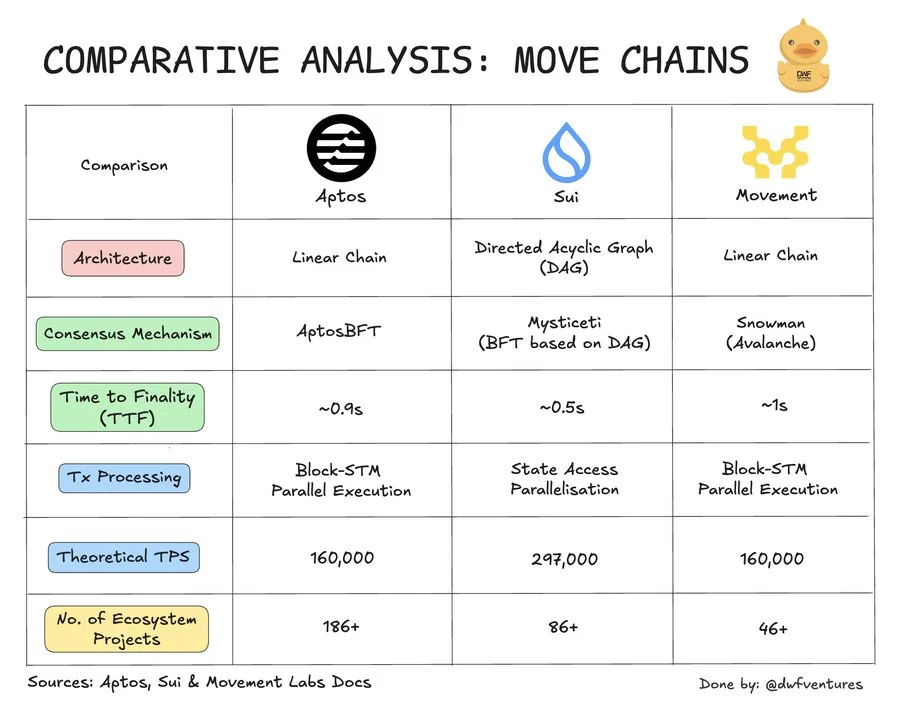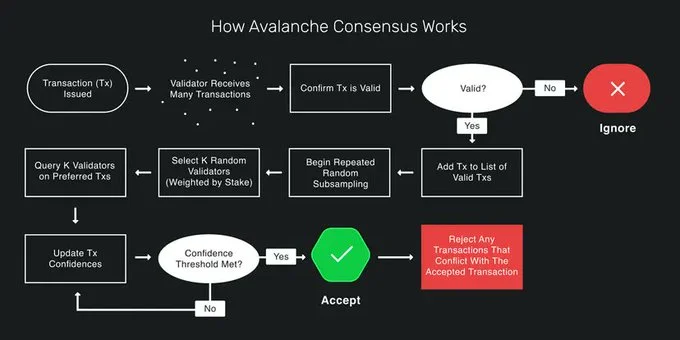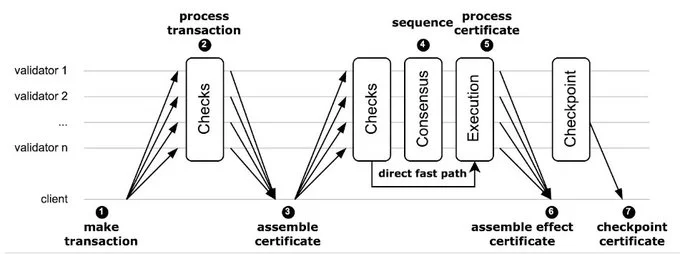Blockchains powered by the Move language are gaining traction, with Aptos, Sui, and the upcoming Movement networks each carving out unique technical approaches. While they all utilise Move, a language designed for security and efficient execution of smart contracts, these blockchains differ significantly. In this article, we explore these key distinctions in more detail. The summary is presented on this graph:

Architecture: Linear vs. DAG
Aptos and Movement follow a traditional linear blockchain architecture, where blocks are processed sequentially. Transactions are batched and state changes occur step by step, making it easier to track changes in a straightforward, linear manner. This structure offers simplicity in design but may introduce bottlenecks as transaction volumes scale.
Sui, on the other hand, adopts a Directed Acyclic Graph (DAG) structure, where transactions can achieve consensus independently within a network of interconnected nodes. This DAG design allows transactions to be processed without waiting for others, significantly increasing throughput and enabling Sui to handle a higher volume of transactions concurrently.

Consensus and Time-to-Finality (TTF)
All three blockchains powered by Move use variations of Byzantine Fault Tolerance (BFT) protocols to achieve consensus while protecting against malicious actors. Here’s how each adapts BFT for performance and security:
- AptosBFT. Aptos enhances efficiency by using a leader-based system: validators communicate only with the designated leader, who is rotated through a voting process, improving coordination and reducing message complexity.
- Sui’s Mysticeti Protocol. Sui’s consensus algorithm allows single validators to sign off on blocks, increasing block capacity and transaction throughput. Multiple leaders are appointed in each round, which enables more transactions to be committed per block, pushing Sui’s average TTF to just around 0.5 seconds.
- Movement’s Snowman Consensus. Movement leverages Avalanche's Snowman protocol, where consensus is reached by sampling a subset of validators. A majority agreement is required, and any conflicting transactions introduce a delay, ensuring secure yet dynamic consensus for quick adjustments under varying network loads.

These consensus mechanisms impact each blockchain’s TTF, with Sui achieving the fastest time due to its DAG and multi-leader approach, while Aptos and Movement trade off some speed for consistency in transaction ordering.
Transaction Processing and TPS
Each blockchain using the Move language implements parallel execution, a method allowing non-conflicting transactions to be processed simultaneously, enhancing scalability and transaction speed:
- Aptos and Movement. Both chains employ Block-STM, an optimistic parallelisation model that assumes all transactions can be processed in parallel, with any conflicting transactions re-executed if necessary. While effective, this approach requires additional resources for re-execution, which could increase load on hardware as transaction volumes rise.
- Object-centric execution in Sui. Sui’s unique method sorts transactions based on the objects they interact with, ensuring that non-conflicting transactions can execute without needing re-execution. Validators verify certificates for each transaction, reducing computational load and enabling Sui to achieve higher TPS without significant strain on hardware.

In total, Sui’s approach to transaction processing offers a more scalable solution, minimising hardware demands while optimising TPS through reduced re-execution, especially beneficial in high-transaction environments.
Ecosystem Development
Aptos, having been established the longest, boasts a larger ecosystem of projects that ranges from DeFi platforms to NFT marketplaces. In addition, Aptos has invested heavily in grant programs to incentivise further development. This enabled Aptos to set up a comprehensive network of builder teams and programs to foster innovation and community building.
In the meantime, Sui and Movement, though newer, are rapidly expanding their ecosystems. Both chains are actively offering grants, setting up incubation programs, and collaborating with developers to promote ecosystem growth. Movement’s testnet activity is already notable, indicating significant developer interest and activity even before its mainnet launch. With continued support for builders and new project funding, both Sui and Movement are positioned for accelerated adoption in the coming months.
Overall
Even though Aptos, Sui, and Movement all utilise the Move programming language, each blockchain has different design choices that influence performance, scalability, and ecosystem.
Aptos’ linear architecture provides simplicity and reliability, Sui’s DAG structure and efficient consensus enable lightning-fast finality, and Movement’s Snowman consensus offers a balance between security and dynamic responsiveness.
Together, these Move-powered blockchains are set to diversify the blockchain landscape, offering developers and users alike varied options tailored to different scalability, transaction, and performance needs.
For those who build on either of the Move blockchains, feel free to reach out to DWF Ventures.